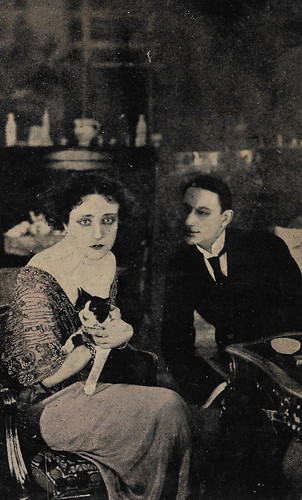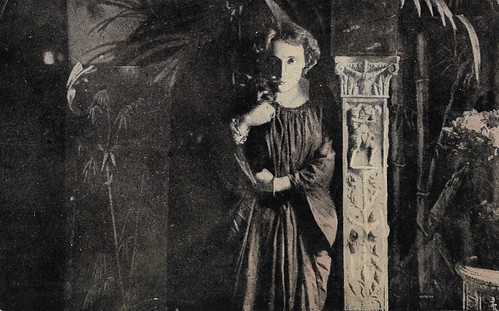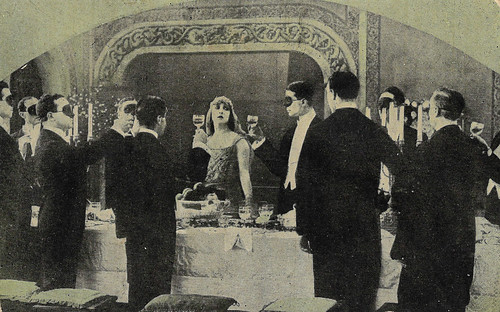Rapsodia satanica (1917)

Spanish collectors card by Chocolate Imperiale, no. 1 of 6 cards. Photo: J. Muntañola, Barcelona / Cines. Lyda Borelli, and Ugo Bazzini in Rapsodia satanica (Nino Oxilia, 1917).

Spanish collectors card by Chocolate Imperiale, no. 2 of 6 cards. Photo: J. Muntañola, Barcelona / Cines. Lyda Borelli, Giovanni Cini, and Andrea Habay in Rapsodia satanica (Nino Oxilia, 1917).

Spanish collectors card by Chocolate Imperiale, no. 3 of 6 cards. Photo: J. Muntañola, Barcelona / Cines. Lyda Borelli and Giovanni Cini in Rapsodia satanica (Nino Oxilia, 1917).
In Rapsodia satanica/Satan's Rhapsody (Nino Oxilia, 1917), the old Contessa Alba d'Oltrevita (Lyda Borelli) deplores her faded youth after a party at her castle. Mephisto (Ugo Bazzini) steps out of a painting and offers her a pact: if she denies love, he will make her young again. She destroys a statuette of Love to conform her renouncement (yet, the sculpture was not entirely broken).
Alba changes into youthful splendour and enjoys the company of young men, in particular the two brothers Tristano and Sergio. Sergio is head over heels in love with her, but she laughs him off. During a costumed ball, in which Alba is dressed as Salome, she gets a note from Sergio, telling her to come out at midnight or he will kill himself. The capricious Alba then seduces Tristano and forces him to choose: either he or his brother will have her. He goes mad and prevents her from going outside.
A shot is heard: Sergio has killed himself. Tristano and Alba are shocked, she pushes him away and closes the castle to mourn her loss. After a while she notices Spring has arrived and revives, covering her rooms with flowers. At nighttime, she notices there is a cavalier on the hills. Could it be Tristano returning? She dresses up like a priestess and goes outside, expecting her lover. But instead, it is Mephisto who punishes her for falling in love and changes her back into the old lady. When seeing herself in the pond, she dies of a heart attack.
As Anthony Kobal writes on IMDb, "Rapsodia Satanica was the last film directed by Nino Oxilia [who was killed in action in 1917] and is undoubtedly one of the finest achievements of the early Italian cinema. In it, Oxilia spins a variation on the Faust myth, embodied here by the diva Lyda Borelli. Typical of extravagant D'Annunzian aestheticism at its height, Rapsodia Satanica was one of the summits of what was later called the "tail coat film." Diametrically opposed to the "cinema of reality" practiced by Serena, Martoglio, and others, "tail coat films" set their melodramatic stories in the salons and villas of the upper-middle class and the aristocracy, deploying narrative structures contrived to showcase their actors and especially its actresses. This had the effect of accentuating their physical presence and turning them into stars - probably the first stars in movie history. The success of the "diva" contributed to the development of motion picture grammar in its special use of the close-up."
This is the first and only film to feature a score written especially for it by famous composer Pietro Mascagni. While already in 1914 Oxilia had started shooting, in 1915 Mascagni was involved and additional footage was shot to please the maestro. While the film was ready that year, it still took two more years to be released, in a reduced and not very successful version.
Only in the 1980s, the film was rediscovered. It was e.g. included in the Dutch retrospective 'Hartstocht en heldendom: Il primo cinema italiano, 1905-1945' (1988), co-organised by Ivo Blom and Nelly Voorhuis. It was still a black-and-white version then, but in 1996 a part monochrome tinted and toned, and part hand-colored version was found at the Cinémathèque Suisse in Lausanne. Thanks to the film archives of Bologna, Milan, and Lausanne the film was analog restored. In 2015 the film was digitally restored in 4K by Bologna and Lausanne. In 2018 Cineteca di Bologna released the 4-films-DVD Dive!, which includes Rapsodia satanica, with the music by Mascagni.

Spanish collectors card by Chocolate Imperiale, no. 4 of 6 cards. Photo: J. Muntañola, Barcelona / Cines. Lyda Borelli and Giovanni Cini in Rapsodia satanica (Nino Oxilia, 1917).

Spanish collectors card by Chocolate Imperiale, no. 5 of 6 cards. Photo: J. Muntañola, Barcelona / Cines. Andrea Habay, Giovanni Cini, and Lyda Borelli in Rapsodia satanica (Nino Oxilia, 1917).

Spanish collectors card by Chocolate Imperiale, no. 6 of 6 cards. Photo: J. Muntañola, Barcelona / Cines. Lyda Borelli in Rapsodia satanica (Nino Oxilia, 1917).
La storia dei tredici (1917)

Spanish collectors card by Chocolate Imperiale, no. 1 of 6 cards. Photo: J. Muntañola, Barcelona / Cines. Lyda Borelli in La storia dei tredici (Carmine Gallone, 1917).

Spanish collectors card by Chocolate Imperiale, no. 3 of 6 cards. Photo: J. Muntañola, Barcelona / Cines. Ugo Piperno in La storia dei tredici (Carmine Gallone, 1917).
La storia dei tredici/The Thirteenth Man (Carmine Gallone, 1917) was made after a script by Lucio d'Ambra based on 'La duchesse de Langeais', one of the three volumes of Honoré de Balzac's tripartite novel 'L'histoire des treize' (1833-39), which appeared as 'Ferragus', 'La duchesse de Langeais' and 'La fille aux yeux d'or'.
A poet, a sculptor, a philosopher, an astronomist, a painter, a musician, and seven other men of culture and pleasure, tired of the joys of wealth, youth, and ardor, unite to heighten their existence under the motto of One for All and All for One. Yet, love is banned. In an ordinary house, they recreate the most ancient pleasures: the court of Pericles, the gardens of Arcadia, etc.
But one of them betrays the pact, falling in love with the Duchess of Langeais (Lyda Borelli). In order to find out who is the trespasser, Count Cent'Anni (Ugo Piperno) orders Montriveaux (Sandro Salvini), the only one who was never in love, to find the guilty one. Yet, it is Montriveaux himself who loves the duchess and who now perseveres with even more ardor the austere virtue of the duchess.
But the friends suspect betrayal and have the duchess abducted. In a masked session, they menace to torture in a cruel way by threatening the duchess with a fire-reddened cross of Lorraine on her forehead. Montriveaux goes berserk and stops the act, betraying himself and is derided. The duchess is escorted home, but when she finds out her persisting lover was the masked man who saved her, her love dies and she decides to join a convent.
Meanwhile, Montriveaux suffers too. Because of the cynic egoism of the Thirteen two lovers have been split, and when remorse sets in, they find out it is too late. Restless, Montriveaux travels all over Europe with Cent'Anni. Finally, at a convent in Spain, they hear an angelic voice in the choir: it is hers. When they plan a second abduction, they find the body of the duchess, whose heart could not take it any longer. But love is stronger than death, the duchess resuscitates, and the lovers are reunited.
La storia dei tredici had its premiere in Rome on 13 October 1917. In 1917, Ugo Ugoletti wrote in the Roman journal Cine-gazzetto that normally film adaptations of literary classics often fail because of a too close following of content and style, but that in this case screenwriter Lucio d'Ambra had well transformed the literary source in a script well fit to the medium of cinema and its popular audience. By just keeping the center of the action, D'Ambra had made a very free adaptation of the novel, the only thing Ugoletti wrote should have been indicated.
On the performance of the actors, he wrote: "Even if not perfect on the whole, the performance by Lyda Borelli is laudable - she is the exquisite animator of unforgettable scenes - in which she shows all of her talent and attraction. In particular, in certain close-ups she managed to reach expressions of marvelous efficacy." Ugoletti also praised the other two actors Salvini and Piperno, the latter marked as 'truly delicious".
Together with Marcia nuziale (Carmine Gallone, 1915), La storia dei tredici is one of the lost films with Lyda Borelli. While most films of Borelli survive, or at least fragments remain (La falena, La dramma di una notte), from this film no footage resurfaced, despite the opening up of film archives in the past decades.

Spanish collectors card by Chocolate Imperiale, no. 4 of 6 cards. Photo: J. Muntañola, Barcelona / Cines. Lyda Borelli in La storia dei tredici (Carmine Gallone, 1917). The man right of Borelli may be the actor Sandro Salvini, the male lead of the film.

Spanish collectors card by Chocolate Imperiale, no. 5 of 6 cards. Photo: J. Muntañola, Barcelona / Cines. Lyda Borelli in La storia dei tredici (Carmine Gallone, 1917).

Spanish collectors card by Chocolate Imperiale, no. 6 of 6 cards. Photo: J. Muntañola, Barcelona / Cines. Lyda Borelli in La storia dei tredici (Carmine Gallone, 1917).
Il dramma di una notte/Una notte a Calcutta (1918)

Spanish collectors card by Chocolat Imperiale, no. 1. Lyda Borelli in Il dramma di una notte/The Drama of One Night aka Una notte a Calcutta/One Night in Calcutta (Mario Caserini 1918). El drama de una noche, the Spanish release title, was released in Spain during WWI by the company José Muntañola, Barcelona. Here we also see Anna Rocchi as Nelly's sister Daisy.

Spanish collectors card by Chocolat Imperiale, no. 3. Lyda Borelli in Il dramma di una notte/The Drama of One Night aka Una notte a Calcutta/One Night in Calcutta (Mario Caserini 1918). El drama de una noche, the Spanish release title, was released in Spain during WWI by the company José Muntañola, Barcelona.
The story of Il dramma di una notte/The Drama of One Night aka Una notte a Calcutta/One Night in Calcutta (Mario Caserini 1918) is about marine officer Guido (unknown actor, in older sources mistakenly indicated as Alberto Capozzi), who returns to Italy to meet his brother's future wife and recognizes Nelly (Lyda Borelli), an 'easy' woman, he once had a story with, in a house of vice in India.
At the time, Nelly took care of her mother and younger sister Daisy (Anna Rocchi). After her mother's death, Nelly repents, returns to Italy, and learns to love with sincerity: Riccardo (Livio Pavanelli).
Nelly begs, then threatens Guido not to tell his brother, but finally accepts to leave without a trace. When she is on her own, she scratches herself with a venous Indian nail varnish she wears and thus kills herself.
This was Lyda Borelli's final film before she married count Vittorio Cini and retired from public life, both the stage and the screen. Il dramma di una notte is a lost film, but a short fragment resurfaced recently at EYE Filmmuseum.

Spanish collectors card by Chocolat Imperiale, no. 4. Lyda Borelli in Il dramma di una notte/The Drama of One Night aka Una notte a Calcutta/One Night in Calcutta (Mario Caserini 1918). El drama de una noche, the Spanish release title, was released in Spain during WWI by the company José Muntañola, Barcelona. The man here next to Borelli, playing Guido, for sure is not Capozzi nor Pavanelli. Actually, he is the same protagonist from Borelli's film Carnevalesca, but alas Vittorio Martinelli's reference books Il cinema muto italiano mix up names for both films, so we still don't know who he is. An enigma...

Spanish collectors card by Chocolat Imperiale, no. 5. Lyda Borelli in Il dramma di una notte/The Drama of One Night aka Una notte a Calcutta/One Night in Calcutta (Mario Caserini 1918). El drama de una noche, the Spanish release title, was released in Spain during WWI by the company José Muntañola, Barcelona. Here Borelli sits in a classic Borellian pose, while the man behind here is Augusto Poggioli. The girl is Anna Rocchi.

Spanish collectors card by Chocolat Imperiale, no. 6. Lyda Borelli in Il dramma di una notte/The Drama of One Night aka Una notte a Calcutta/One Night in Calcutta (Mario Caserini 1918). El drama de una noche, the Spanish release title, was released in Spain during WWI by the company José Muntañola, Barcelona.
Sources: Vittorio Martinelli (Il cinema muto italiano, Vol. 1917), IMDb, and plot on the back of the cards.
No comments:
Post a Comment